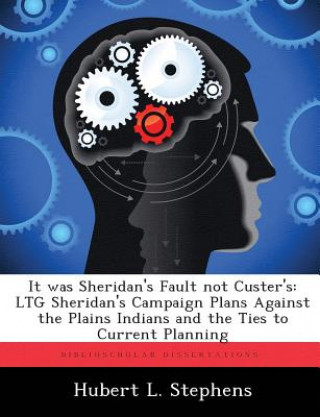
Code: 08240793
It Was Sheridan's Fault Not Custer's
by Hubert L Stephens
Martin van Creveld, a noted theorist, contends that the concept of operational art did not take off in the United States (US) until after the Vietnam War. Conversely, James Schneider, a prominent military theorist, asserts that op ... more
- Language:
 English
English - Binding: Paperback
- Number of pages: 84
Publisher: Biblioscholar, 2012
- More about this

You might also like
-

Cukrfree
11.77 € -19 % -

Geschenkpapier Roman grün hell (Rolle, 30 cm)
106.61 € -

Overcome the Hand That's Dealt
18.41 € -

Right and Left.
26.27 € -19 % -

Lost in the USA
19.42 € -

Military History of the Late Prince Eugene of Savoy, and of the Late John Duke of Marlborough, Including a Particular Description of the Several Battl
36.43 € -

Marriage in May Fair
17.61 € -18 %
Give this book as a present today
- Order book and choose Gift Order.
- We will send you book gift voucher at once. You can give it out to anyone.
- Book will be send to donee, nothing more to care about.
More about It Was Sheridan's Fault Not Custer's
You get 150 loyalty points
 Book synopsis
Book synopsis
Martin van Creveld, a noted theorist, contends that the concept of operational art did not take off in the United States (US) until after the Vietnam War. Conversely, James Schneider, a prominent military theorist, asserts that operational art began in the American Civil War. This monograph provides a holistic analysis of four Plains Indian War Campaigns. Lieutenant General (LTG) Philip Sheridan conducted all four campaigns. This analysis illustrates several enduring principles of both operational art and counterinsurgency (COIN) operations. The purpose of the monograph is to explain the initial failure of LTG Sheridan's 1876 Centennial Campaign against the Sioux and Cheyenne Indians. Additionally, this explanation relates the significance of LTG Sheridan's planning to contemporary COIN campaign planning. The overall methodology is the incorporation of four case studies to test the theory of sanctuary control and elimination of resources to defeat insurgencies. The four case studies include: the 1868-1869 Cheyenne War, the 1874-1875 Red River War, the 1876 Centennial Campaign, and the 1876-1877 Sioux Campaign. The case studies use three essential structural variables or frameworks. The first framework evaluates the strategic context to deduce the strategic aims and operational objectives. This provides the ends that the Army or tribe attempted to achieve. The second structural analysis uses the elements of operational art described to assess the campaigns. The third aspect of the case study evaluates tenets of current US Army COIN principles. The monograph contains three key findings. The first key finding is that the failure at the Little Big Horn was LTG Sheridan's fault not LTC Custer's, and this directly relates to the second finding. The second key finding is the importance of operational art in designing a campaign plan to link tactical actions to strategic objectives. The third finding is the efficacy of some of the current COIN tenets. The doctrinal analysi
 Book details
Book details
Book category Books in English Society & social sciences Education
59.79 €
- Full title: It Was Sheridan's Fault Not Custer's
- Subtitle: Ltg Sheridan's Campaign Plans Against the Plains Indians and the Ties to Current Planning
- Author: Hubert L Stephens
- Language:
 English
English - Binding: Paperback
- Number of pages: 84
- EAN: 9781288280988
- ISBN: 9781288280988
- ID: 08240793
- Publisher: Biblioscholar
- Weight: 168 g
- Dimensions: 246 × 189 × 4 mm
- Date of publishing: 01. November 2012
Trending among others
-

Cambridge IGCSE (R) & O Level Complete Physics: Student Book Fourth Edition
41.97 € -

Cambridge IGCSE (R) & O Level Complete Biology: Student Book Fourth Edition
41.97 € -

Cambridge IGCSE (R) & O Level Complete Chemistry: Student Book Fourth Edition
50.93 € -

Oxford IB Diploma Programme: IB Economics Course Book
62.31 € -

Oxford IB Diploma Programme: IB Theory of Knowledge Course Book
57.98 € -

Oxford International Primary Science Second Edition: Workbook 4
14.99 € -

Business Partner B1 Workbook
17.71 € -7 % -

AQA French A Level Year 1 and AS
50.33 € -

CompTIA Security+ Review Guide - Exam SY0-601
24.76 € -24 % -

Cambridge IGCSE (R) & O Level Complete Biology: Print and Enhanced Online Student Book Pack Fourth Edition
61.10 € -

geog.2 Workbook
11.47 € -6 % -

Oxford IB Study Guides: Economics for the IB Diploma
47.71 € -

Teach Reading With Orton-gillingham
18.82 € -10 % -

KS3 Maths 10-Minute Weekly Workouts - Year 7
8.04 € -8 % -

Blue Book of Grammar and Punctuation: An Easy- to-Use Guide with Clear Rules, Real-World Examples , and Reproducible Quizzes, Twelfth Edition
15.09 € -28 % -

Business Partner B1+ Workbook
16.80 € -3 % -

Powerful Teaching: Unleash the Science of Learning
26.17 € -26 % -

Business Partner B2 Workbook
16.80 € -3 % -

Embodied Teen
21.64 € -16 % -

(ISC) SSCP SG & SSCP Practice Test Kit, 3e
65.13 € -27 % -

Growth Mindset Classroom-ready Resource Book
16.20 € -28 % -

AQA A Level Biology Revision Guide
25.56 € -5 % -

UKCAT For Dummies
23.15 € -28 % -

Oxford International Primary Maths Second Edition: Practice Book 1
12.17 € -

Oxford International Primary Science Second Edition: Student Book 1
26.77 € -

Donny's Unauthorized Technical Guide to Harley Davidson 1936 to Present
47.91 € -16 % -

OET Speaking for Nurses Book 2
11.57 € -2 % -

Edexcel International GCSE Chemistry Student Book Second Edition
31.60 € -14 % -

Oxford International Primary Maths Second Edition: Practice Book 2
12.17 € -

Cambridge IGCSE (R) & O Level Complete Physics: Print and Enhanced Online Student Book Pack Fourth Edition
62.91 € -

OET Speaking For Nurses Book 1
12.78 € -

Walk Your Talk; Tools and Theories To Share Nonviolent Communication
29.29 € -

Oxford International Primary Maths Second Edition: Practice Book 3
13.58 € -

Social Skills Activities for Secondary Students wi th Special Needs, Third Edition
26.37 € -21 % -

AQA GCSE German Foundation Practice Papers
15.29 € -

geog.1 5th edition Workbook Answer Book
56.37 € -

New KS2 English Year 5 Foundation Grammar, Punctuation & Spelling Targeted Question Book w/Answers
8.95 € -5 % -

Making Escape Rooms for Educational Purposes
18.72 € -

Cambridge IGCSE (R) & O Level Complete Chemistry: Print and Enhanced Online Student Book Pack Fourth Edition
62.91 € -

New KS2 English Year 4 Foundation Grammar, Punctuation & Spelling Targeted Question Book w/Answers
8.95 € -5 % -

Oxford International Primary Maths Second Edition: Practice Book 5
16.10 € -

Education in the New Age
12.88 € -

240 Vocabulary Words Kids Need to Know: Grade 3
11.77 € -17 % -

Oxford IB Diploma Programme: Oxford IB Diploma Programme: IB Mathematics: applications and interpretation Standard Level Enhanced Online Course Book
95.13 € -

OET Preparation
9.65 € -

Speed and Accuracy: Multiplication
8.65 € -

ESL/ELL Teacher's Survival Guide: Ready-to-Use Strategies, Tools, and Activities for Teaching En glish Language Learners of All Levels, 2nd Edition
29.69 € -21 % -

KS3 Maths 10-Minute Weekly Workouts - Year 8
8.04 € -8 % -

Speed and Accuracy: Division
8.65 €
Collection points Bratislava a 2642 dalších
Copyright ©2008-24 najlacnejsie-knihy.sk All rights reservedPrivacyCookies



 15549 collection points
15549 collection points Delivery 2.99 €
Delivery 2.99 € 02/210 210 99 (8-15.30h)
02/210 210 99 (8-15.30h)